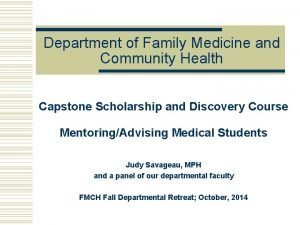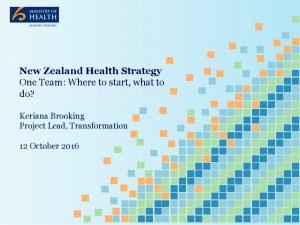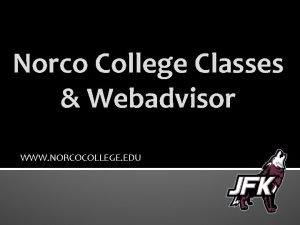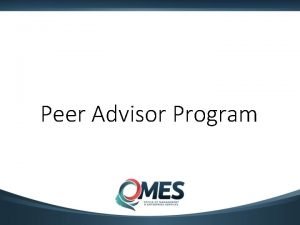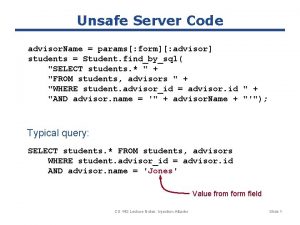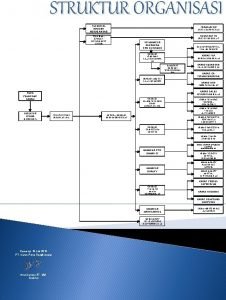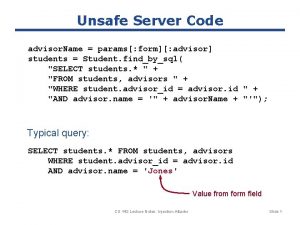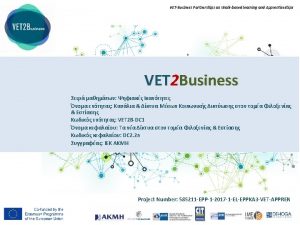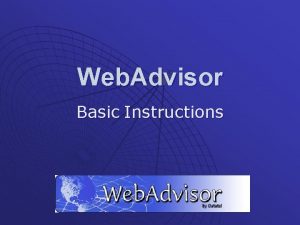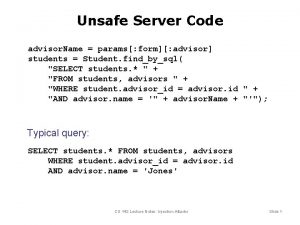Health Care IT Advisor 2016 Health Care IT












- Slides: 12

Health Care IT Advisor 2016 Health Care IT Top Ten Ways Information Technology Can Support Value -Based Care Transformation

2 Ten Ways IT Can Support Value-Based Care Quality Reporting Consumer Loyalty IT leaders may be tasked with regulatory compliance for programs that involve clinical quality measurement. Preparing for this challenge requires that they align program reporting; assign staff to monitor for policy changes; and prepare for electronic measure submission. Information Technology will be critical to give customers what they really want from their care experience and move them beyond satisfaction to gain the ongoing loyalty required by value-based care and bundled payments. EMR Optimization Mobility To avoid getting stuck in an ongoing cycle of optimization, target a few strategic outcomes that can be achieved with the help of the technology and shift the majority of your resources to a focus on those outcomes. Mobile technology and the Internet of Things (Io. T) are making health care easier to access and providing new sources of data that will require more complex intelligence to turn this data into action. Interoperability Business Intelligence Interoperability standards continue to evolve to support a growing need for open data access between diverse systems and active (often mobile) users in an ever-more complex health care ecosystem. New business and clinical challenges resulting from value-based care, population health management, and margin management will require organizations more advanced analytics and big data capabilities. Population Health Management Digital Health Systems Provider organizations assuming financial risk are being forced to choose between the functionality of their EMR versus niche applications to accomplish all of the processes necessary to succeed with population health management. Digital health systems will take full advantage of digital technologies and IT-related capabilities to redefine business models; improve processes, quality and their cost structure; and identify and address customer Telemedicine IT Performance Management Lead by direct-to-patient virtual care, telemedicine will evolve to become the glue that holds together care continuity across the continuum. As providers become ever more reliant on IT to thrive in this time of health care transformation, they must invest in optimizing their IT cost structure and performance management capabilities to ensure an optimal return. © 2016 The Advisory Board Company • advisory. com • 31896 A or patient needs.

Quality Reporting: Programs Plentiful, Alignment Elusive But Beneficial Quality Is Central to Programs Tied to Value-Based Payment Models Voluntary Programs • Bundled Payments for Mandatory Programs • Health Care Improvement Initiative (BPCI) • Hospital Value- Payment Learning and Action Network • Alternative Payment • Next-Generation Models (APMs) • Inpatient Quality ACO • Pioneer ACO • Meaningful Use 1 • Patient-Centered • Medicare Shared • Value-Based • Hospital Readmissions Reduction Program • Comprehensive Care for Joint Replacement Model Payment Modifier 1 Savings Program • Oncology Care Model Hospital-Acquired Condition Reduction Program Reporting Program • Million Hearts Medical Home • Based Purchasing Program Example of an opportunity available to align quality reporting requirements across these programs • Physician Quality • Comprehensive Primary Care Initiative Reporting System 1 Fee for Service Increasingly Tied to Value 90% Percentage of Medicare Payments Tied to Quality by 2018 1) To be incorporated into the Merit-Based Incentive Payment System (MIPS) in 2019. © 2016 The Advisory Board Company • advisory. com • 32104 Sources: Health Care IT Advisor Board research and analysis. 3

4 Don’t Get Stuck on the Way to IT Optimization Drive focus of optimization efforts to strategic value as rapidly as possible Proportion of Staff Hours 1 1. Strategic Value 1 2 2 3 1 2 3 2. User Experience/Process 2 2 3 3 Planning 3 1 Design/Build Optimization Stabilization Choke Point 1: Technical and Process Gaps © 2016 The Advisory Board Company • advisory. com • 32104 1 3. Technical stability/functionality Go live Choke Point 2: Clinicians Not Fully Using IT Choke Point 3: Strategic Value Not Achieved

5 Interoperability: Finding the Best Approach HL 71 Evolution a Key Component to Meeting Changing Market Needs Too Loose? Standard Primary Use Adoption • • • Too Large? Just Right? HL 7 2. x HL 7 3. x, CDA, 2 CCDs 3 Inter-Departmental Messages Inter-Organizational Documents Inter-Anyone Data Access High – Foundational Workhorse, but… Medium – An Enabler of Meaningful Use, but… Nascent – With Lots of Positive Excitement Too much ambiguity • Proprietary pretending to be standards-based (e. g. , Z segments) Over-engineered given current business needs • Too much data, redundancy and set-up Too brittle and often pointto-point • Too costly 1990 s Interoperability Goals: 2000 s HL 7 Open APIs, 4 FHIR 5 • Based on modern platforms • • • Uses common data sets Supports mobility Gets only what you need 2015+ Enabling notifications, referrals, transitions of care, data sharing, care coordination, patient engagement… 1) HL 7 = Health Level 7 2) CDA = Clinical Document Architecture. 3) CCD = Continuity of Care Document. 4) API = application program interface. 5) FHIR = Fast Healthcare Interoperability Resources. © 2016 The Advisory Board Company • advisory. com • 32104 Source: Health Care IT Advisor research and analysis.

6 Population Health Management Enterprise EMR vs. Niche/Suite Systems: 2016 Risk Segmentation Chronic Disease Management Patient-Centric Care Delivery High-Risk Patient Management Improved Patient Engagement Analytics for Knowledge Generation Enterprise EMR © 2016 The Advisory Board Company • advisory. com • 32104 Niche/Suite System

7 Telemedicine: Addressing Gaps and Transitions in Care Improving Inefficiencies Through Virtual Care Transitions in Care Recommendations: Review engagement strategies and transition of care processes Virtual Visits to Manage Chronic Care Hospital to Home/Follow up Check-ins After Physician Visit © 2016 The Advisory Board Company • advisory. com • 32104 Ensure all platforms align and reinforce each other When Developing A Virtual Care Strategy, Consider: • Types of Mobile Platforms Available • Patient Selfscheduling • 24 x 7 availability

8 Leverage IT To Gain Consumer Loyalty IT can enable a superior, differentiated consumer experience Level of Service Provided Loyalty (exceeding expectations, different than competitors) Where IT Can Make the Difference Convenience • Easier scheduling • Shorter wait times for appointments • Remote visits to improve convenience and accessibility • Friendlier, easier, more private admission/check-in processes Engagement Satisfaction (meeting basic expectations) • Shared/informed decision-making for care decisions • Ability for patients to see, understand, contribute to their own medical record • Rapid, convenient access to test and procedure results Transparency Dis-satisfaction (not meeting expectations) • Ability to evaluate, compare, select providers based on cost, quality, service • Knowing the true cost of care before it is received © 2016 The Advisory Board Company • advisory. com • 32104

9 Mobility and Io. T 1: Outburst or Outbreak? More Devices, Apps, Capabilities and Management/Security Challenges Mobility is moving from optional, to mainstream, to ubiquitous The days of managing a few corporate-selected operating systems, device types, and apps are over Sensors, Monitors, Ingestibles, MEMS, 2 Nanotechnology (Tens of Billions) Medical Devices, Appliances, Fitness Trackers, Drones, Smart Watches, Cameras, Security Systems, Thermostats (Billions) Smartphones, Tablets, Phablets (Hundreds of Millions) Essential Capabilities • • Vetted App Stores Remote Patient Monitoring for Chronic Diseases RTLS 3 for Presence and Context • Mobile Device Management • Mobile Application Management • Multi-layered Security Systems Mobile-enabled Unified Communications 1) Io. T = Internet of Things. 2) MEMS = Microelectromechanical Systems. 3) RTLS = Real Time Location System. © 2016 The Advisory Board Company • advisory. com • 32104 Source: Health Care IT Advisor research and analysis.

10 BI: Good Progress, Still a Long Way to Go Still Room for Data Coordination and Consolidation Stage of Maturity on the BI Maturity Model ! 20151 Observations • Many organizations will likely remain in the Enterprise Phase for a significant period of time 73% 19% Fragmented 8% Enterprise Advanced Analytics 0% • Value-based payments, PHM and the retail environment will force most organizations to develop more advanced analytics and big data capabilities Big Data 1) 2015 n = 48. © 2016 The Advisory Board Company • advisory. com • 32104 Source: Health Care IT Advisor research and interviews

11 Digital Health Systems: IT-Enabled and IT-Driven Organizational Strategies and Digital Strategies Must Converge People, Process and Technology Change IT-driven industry transformation IT-enabled strategies IT as a cost to be minimized The focus of digital health systems IT as efficiency tool 1980 s and 1990 s and 2000 s Current and Future Digital health systems take full advantage of digital technologies and ITrelated capabilities to redefine business models; improve processes, quality, and their cost structure; and identify and address customer or patient needs. © 2016 The Advisory Board Company • advisory. com • 32104 Source: Health Care IT Advisor research and analysis.

IT Cost and Performance Management: Time for a Check-up Providers Will Need More From IT Staffing and Organization Review & Update Governance and Planning Assess Technical Capabilities ü IT service catalogue Aim ü Current skills and needs Study ü Application portfolio ü Set business and Plan ü New technologies IT Operations ü Project portfolio ü IT metrics Improve clinical outcomes Quantify ü Determine IT capacity limits ü Leverage Lean, Agile, and ITIL 1 Align ü Future needs Develop ü Skills for cloud computing, virtualization, analytics, integration, and security ü Hold regular oneon-one meetings with key leaders. like cloud, virtualization, mobility, Io. T, 2 Hadoop Deploy ü To lower costs, reduce workloads, increase agility Look for Improvement Opportunities Provider organizations should conduct a check-up on the key factors in IT performance. 1) ITIL = Information Technology Infrastructure Library. 2) Io. T = Internet of Things Source: The Advisory Board Company analysis. © 2016 The Advisory Board Company • advisory. com • 32104 12
 Family and community health advisor
Family and community health advisor Primary secondary tertiary care nursing
Primary secondary tertiary care nursing Care value base health and social care
Care value base health and social care New zealand health strategy 2016
New zealand health strategy 2016 Health and social care component 3
Health and social care component 3 Uqam library
Uqam library Uwb degree audit
Uwb degree audit Umr plan advisor
Umr plan advisor Transfer credit advisor uncc
Transfer credit advisor uncc Fidelity advisor 529
Fidelity advisor 529 Ucdavis siss
Ucdavis siss Ramon magsaysay contribution
Ramon magsaysay contribution Norco college class schedule
Norco college class schedule
